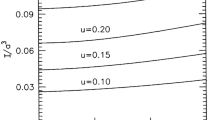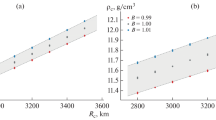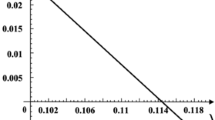Abstract
The core–envelope analytic models of Negi et al. (Class. Quantum Gravity 6:1141, 1989) have been found to be consistent with both the mechanisms of glitch generation in pulsars, namely (i) the starquake model and (ii) the vortex unpinning model. In Negi (Astrophys. Space Sci. 364:149, 2019, arXiv:2105.14324), the author has been able to reproduce the observed values of the glitch healing parameter, \(G_{h}\) (\(= I_{\mathrm{core}}/I_{\mathrm{total}}\); \(G_{h}\) represents the fractional moment of inertia of the core component in the starquake mechanism of glitch generation) for the Crab as well as for the Vela pulsar. In another study, by using the models discussed in Negi et al. (Class. Quantum Gravity 6:1141, 1989), the author has obtained the minimum value of fractional moment of inertia of the crust about 7.4% and larger for all the values of masses in the range \(1M_{\odot }\)–\(1.96M_{\odot }\) considered for the Vela pulsar (Negi in J. Eng. Sci. 11:86, 2020a, arXiv:2106.02439). The latter study of the author is found to be consistent with the recent requirement (on the basis of vortex unpinning model of the glitch generation) which reveals that the minimum fractional crustal moment of inertia of the Vela pulsar should be about 7% for a mass higher than about 1\(M_{\odot }\). However, a thorough study which requires investigation of pulsational stability and gravitational binding of the models of Negi et al. (Class. Quantum Gravity 6:1141, 1989) has not been carried out so far. The present paper deals with such a study of the models (Negi et al. in Class. Quantum Gravity 6:1141, 1989) for all permissible values of the compactness parameter \(u\) (\(\equiv M/a\), the total mass to size ratio in geometrized units) and compressibility factor \(Q\) (defined in Tolman’s VII solution as \(x = r^{2}/K^{2} = r^{2}/a^{2}Q\)). It is seen that the configurations remain pulsationally stable and gravitationally bound for all permissible values of \(u\) \((\leq 0.25)\) and \(Q\) (\(0 < Q \leq 1.2\)).








Similar content being viewed by others
Notes
For simplification these expressions are obtained by using the ‘trial function’ \(\xi = re^{\nu /2}\), because this trial function is sufficient to judge the pulsational stability as obtained by using the trial function of the form of a power series (Negi and Durgapal 1999; Negi 2007; and the references therein) \(\xi = b_{1}r(1 + a_{1}r^{2} + a_{2}r^{4} + a_{3}r^{6})e^{\nu /2}\), where \(a_{1}\), \(a_{2}\), and \(a_{3}\) are arbitrary constants. Furthermore, the study of Knutsen (1989) also shows that the use of the trial function of the form of a power series mentioned above (with suitable values of the arbitrary constants \(a_{1}\), \(a_{2}\), and \(a_{3}\) such that the appropriate boundary conditions may be satisfied) provide results similar to those obtained by using the trial function \(\xi = re^{\nu /2}\).
References
Alpar, M.A., Chau, H.F., Cheng, K.S., Pines, D.: Astrophys. J. 409, 345 (1993)
Alpar, M.A., Chau, H.F., Cheng, K.S., Pines, D.: Astrophys. J. 459, 706 (1996)
Anderson, P.W., Itoh, N.: Nature 256, 25 (1975)
Andersson, N., Glampedakis, K., Ho, W.C., Espinoza, C.M.: Phys. Rev. Lett. 109, 241103 (2012)
Baym, G., Pines, D.: Ann. Phys. 66, 816 (1971)
Brecher, K., Caporaso, G.: Nature 259, 377 (1976)
Chamel, N.: Phys. Rev. Lett. 110, 011101 (2013)
Chandrasekhar, S.: Phys. Rev. Lett. 12(114), 437 (1964a)
Chandrasekhar, S.: Astrophys. J. 140, 417 (1964b)
Durgapal, M.C., Pande, A.K.: Indian J. Pure Appl. Phys. 18, 171 (1980)
Durgapal, M.C., Pande, A.K., Fuloria, R.S.: Astrophys. Space Sci. 102, 49 (1984)
Haensel, P., Potekhin, A.Y., Yakovlev, D.G.: Neutron Stars 1. Equation of State and Structure. Springer, Berlin (2006)
Hartle, J.B.: Phys. Rep. 46, 201 (1978)
Kalogera, V., Baym, G.: Astrophys. J. 470, L61 (1996)
Knutsen, H.: Astrophys. Space Sci. 162, 315 (1989)
Lattimer, J.M., Prakash, M.: Phys. Rev. Lett. 94, 111101 (2005)
Moustakidis, C.C.: Gen. Relativ. Gravit. 49, 68 (2017)
Negi, P.S.: Gen. Relativ. Gravit. 39, 529 (2007)
Negi, P.S.: Astrophys. Space Sci. 364, 149 (2019). arXiv:2105.14324
Negi, P.S.: J. Eng. Sci. 11, 86 (2020a). arXiv:2106.02439
Negi, P.S.: Astrophys. Space Sci. 365, 32 (2020b). arXiv:2106.01197
Negi, P.S., Durgapal, M.C.: Gen. Relativ. Gravit. 31, 13 (1999)
Negi, P.S., Durgapal, M.C.: Astrophys. Space Sci. 275, 185 (2001)
Negi, P.S., Pande, A.K., Durgapal, M.C.: Class. Quantum Gravity 6, 1141 (1989)
Oppenheimer, J.R., Volkoff, G.M.: Phys. Rev. 55, 374 (1939)
Rhoades, C.E. Jr., Ruffini, R.: Phys. Rev. Lett. 32, 324 (1974)
Ruderman, M.: Astrophys. J. 203, 213 (1976)
Shapiro, S.L., Teukolsky, S.A.: Black Holes, White Dwarfs, and Neutron Stars: The Physics of Compact Objects. Wiley, New York (1983)
Stephani, H., Kramer, D., MacCallum, M., Hoenselaers, C., Herlt, E.: Exact Solutions of Einstein’s Field Equations, 2nd edn. Cambridge University Press, Cambridge (2003)
Wiringa, R.B., Fiks, V., Fabrocini, A.: Phys. Rev. C 38, 1010 (1988)
Zeldovich, Ya.B., Novikov, I.D.: Relativistic Astrophysics, Vol I. University of Chicago Press, Chicago (1978)
Author information
Authors and Affiliations
Corresponding author
Ethics declarations
Conflict of interest statement
The author declares that there is no conflict of interest.
Additional information
Publisher’s Note
Springer Nature remains neutral with regard to jurisdictional claims in published maps and institutional affiliations.
Rights and permissions
About this article
Cite this article
Negi, P.S. The stability of core-envelope models for the Crab and the Vela pulsars. Astrophys Space Sci 366, 78 (2021). https://doi.org/10.1007/s10509-021-03985-9
Received:
Accepted:
Published:
DOI: https://doi.org/10.1007/s10509-021-03985-9




